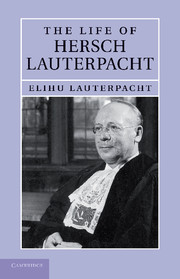Book contents
- Frontmatter
- Contents
- List of plates
- Acknowledgments
- List of abbreviations
- Prologue and introduction
- 1 Background and early years, 1897–1919
- 2 Vienna: research, engagement and marriage, 1919–1923
- 3 England and the London School of Economics, 1923–1937
- 4 Cambridge, 1937–1939: the Whewell Chair
- 5 The war years, Part I: September 1939–January 1941
- 6 The war years, Part II: February 1941–March 1942
- 7 The war years, Part III: April 1942–December 1944
- 8 Human rights
- 9 The years of practice, 1945–1950
- 10 1950–1954
- 11 The International Court of Justice, 1955–1960
- Epilogue: the man
- Appendix 1 The published writings of Sir Hersch Lauterpacht
- Appendix 2 Biographical and academic writings on Sir Hersch Lauterpacht
- Appendix 3 Obituaries of Sir Hersch Lauterpacht
- Appendix 4 Chronology of significant events in the life of Sir Hersch Lauterpacht
- Index
Prologue and introduction
Published online by Cambridge University Press: 01 June 2011
- Frontmatter
- Contents
- List of plates
- Acknowledgments
- List of abbreviations
- Prologue and introduction
- 1 Background and early years, 1897–1919
- 2 Vienna: research, engagement and marriage, 1919–1923
- 3 England and the London School of Economics, 1923–1937
- 4 Cambridge, 1937–1939: the Whewell Chair
- 5 The war years, Part I: September 1939–January 1941
- 6 The war years, Part II: February 1941–March 1942
- 7 The war years, Part III: April 1942–December 1944
- 8 Human rights
- 9 The years of practice, 1945–1950
- 10 1950–1954
- 11 The International Court of Justice, 1955–1960
- Epilogue: the man
- Appendix 1 The published writings of Sir Hersch Lauterpacht
- Appendix 2 Biographical and academic writings on Sir Hersch Lauterpacht
- Appendix 3 Obituaries of Sir Hersch Lauterpacht
- Appendix 4 Chronology of significant events in the life of Sir Hersch Lauterpacht
- Index
Summary
This is the life of Sir Hersch Lauterpacht, who lived from 1897 to 1960. In his time, he was regarded, and still is, as a pre-eminent international lawyer devoted to the advancement of peace between States on the basis of law. To that end, he rejected the unbridled assertion of sovereignty by States and emphasised the fundamental rights of the individual. He was a prolific legal writer whose works carried great authority. His life fell into four parts: his early years in Eastern Europe from 1897 to 1923, followed by his marriage and emigration to England where he began a distinguished academic career. After the end of the Second World War, he became more involved in the profession of international law in which he used his great knowledge and literary capacity to powerful effect. Finally, he spent five years as a judge of the International Court of Justice, dying in office at the early age of 62.
His life was one of almost unremitting labour, on his own behalf, on behalf of his students and on behalf of governments or other clients. And coupled with this was an intense devotion to his wife, Rachel, and his only child, the author of this book.
The biography draws heavily on a major accumulation of family correspondence exchanged between Hersch, Rachel and myself over a period of nearly thirty years. It is supported by consideration of his writings which tell us much about his attitude towards life.
- Type
- Chapter
- Information
- The Life of Hersch Lauterpacht , pp. 1 - 8Publisher: Cambridge University PressPrint publication year: 2010

